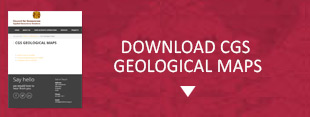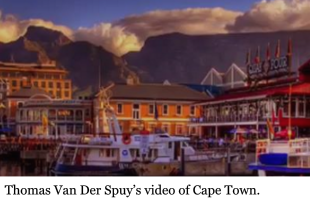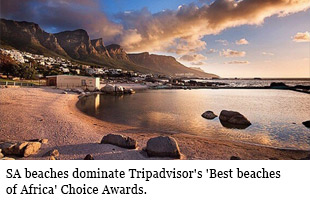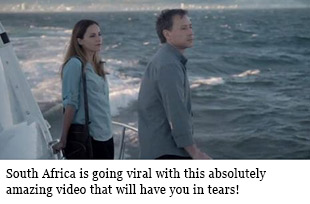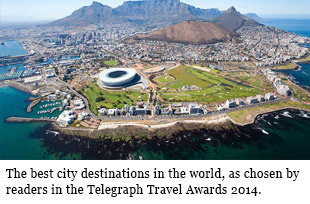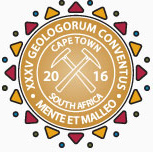
35TH INTERNATIONAL GEOLOGICAL CONGRESS
27 AUGUST - 4 SEPTEMBER 2016 | CAPE TOWN, SOUTH AFRICA
Sponsors



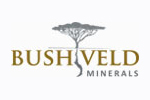


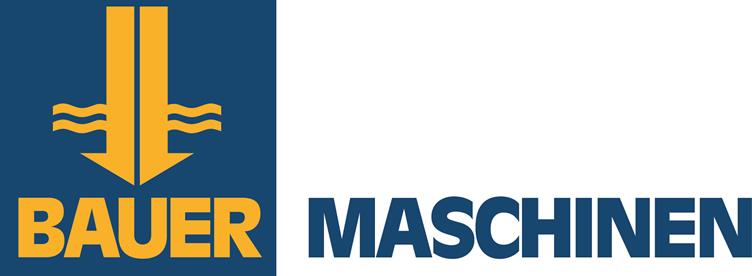










35 IGC SAGPGF





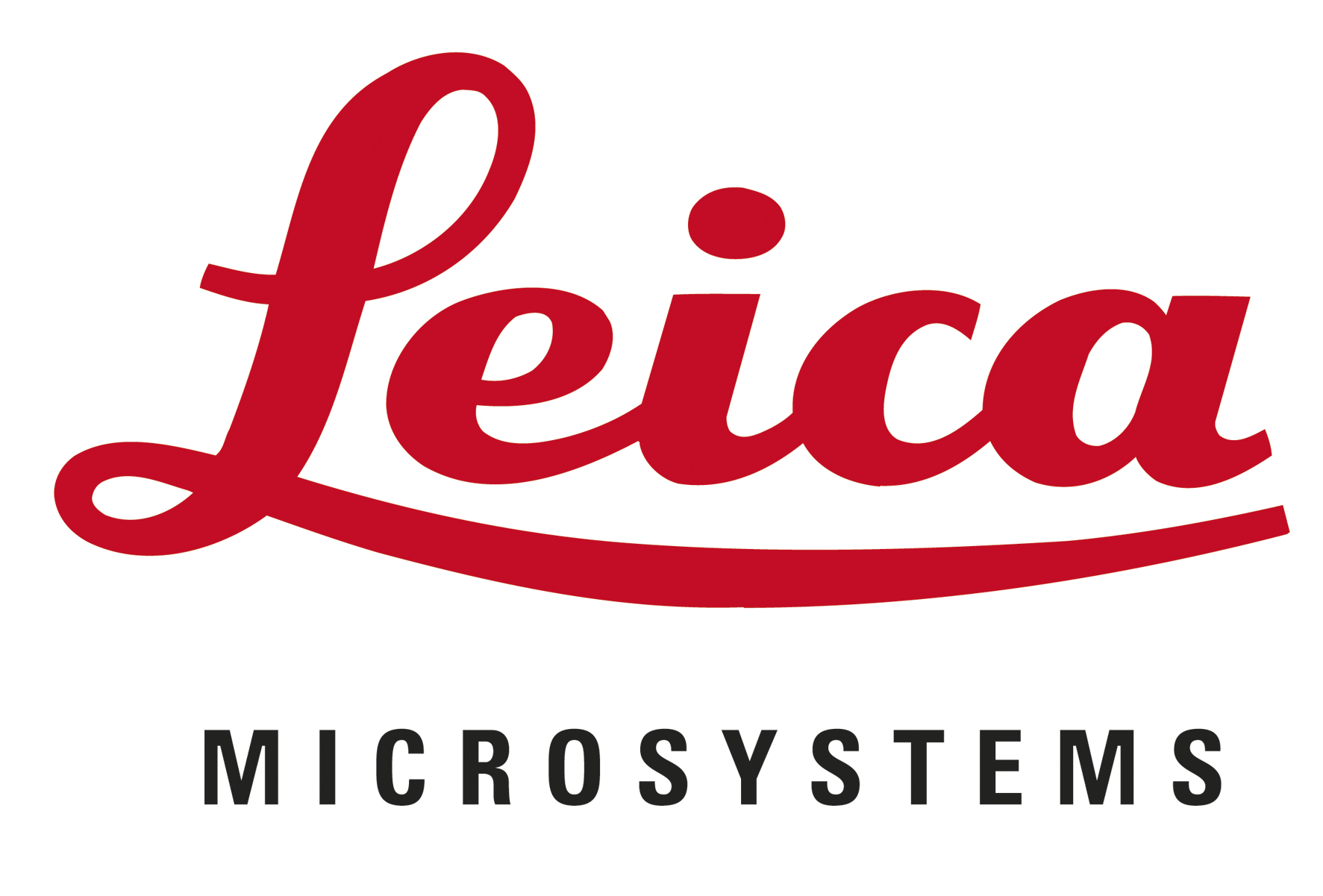

35TH INTERNATIONAL GEOLOGICAL CONGRESS
27 AUGUST - 4 SEPTEMBER 2016 | CAPE TOWN, SOUTH AFRICA
My IGC
The Great Southern African Train Geo-Safari
35th International Geological Congress “Flagship” Field Trip
Sunday 4th to 13th September 2016
No of days: 10 Days
Travel from Cape Town to Victoria Falls on the Shongololo Express Heritage Train
From R36,000 per person sharing
This once-in-a-lifetime field trip will start directly after the 35th IGC when the Shongololo Express departs from Cape Town and it will end at Victoria Falls (Zimbabwe) 10 days later. En route there will be geological and general interest day excursions to a variety of important sites, including the Swartberg Pass in the Karoo, the Big Hole in Kimberley, Sterkfontein Caves and the Cradle of Humankind, seeing the Witwatersrand, Mapungubwe National Park, Great Zimbabwe National Monument and the Matoba Hills. Passengers will see the Victoria Falls on the Zambezi River, visit Livingstone in Zambia, and go on a river safari in Botswana’s Chobe National Park.
You will travel, dine and sleep throughout on the comfortable and privately-owned Shongololo Express train. All compartments have 2 beds and en-suite toilet facilities. While a vast distance will be covered (see map) travel will mostly be at night. All day excursions, using mini-buses and drivers that are carried on the train, are included in the tour price. This field trip is endorsed by the 35th IGC and will be run by JB Train Tours, an experienced railway tour operator (see www.jbtours.co.za) but only 70 passengers can be accommodated. In Cape Town passengers will be collected at their hotel and transferred to the station, and at the end passengers need to make their own onward travel arrangements from Victoria Falls.
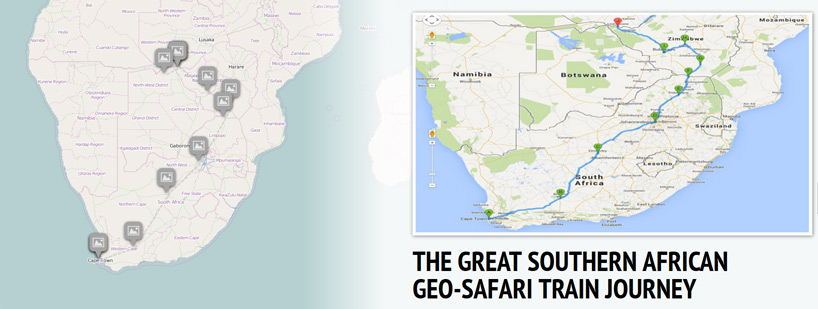
| To view the field trips story map please click here |
| To express an interest in the above safari please click here. |
Geological Day Excursions: At each site of geological interest we will make use of local experts to share their knowledge with you. An overview of the daily, geologically-focussed excursions is provided in the itinerary below, and this includes a number of tourist destinations of more general interest. More details will become available closer to the field trip and a comprehensive guidebook will be provided on departure. At the moment the trip looks like this:
Sunday 4th (Day 1): Depart Cape Town at 11 a.m. for Prince Albert Road; includes a short stop at Matjiesfontein village
Geology and landscape: After crossing the sandy Cape Flats and passing the intrusive Precambrian granite domes of Paarl Mountain the train winds its way through the intensely folded Hex River Mountains of the Ordovician-Devonian Cape Supergroup where you will enjoy the breathtaking scenery of vineyards and fold mountains. The train will make a brief stop at the Victorian village of Matjiesfontein at the start of the Great Karoo where the geology of the lower part of the Karoo Supergroup will be explained, and which is now prime exploration country for shale gas. The train will arrive late evening at Prince Albert Road station.
Monday 5th September (Day 2): Road trip across Swartberg Pass and Meiringspoort; overnight from Beaufort West to Kimberley
Geology and landscape: Passengers depart by mini-bus to Prince Albert village at the entrance to the magnificent Swartberg Pass for one of the geologically most impressive day tours. Carboniferious-Permian Dwyka tillite will be seen before venturing into the northern end of the Swartberg Pass and incredible folding is seen as you make your way across the entire Cape Bold Belt. On the southern side of the pass there are intensely deformed Precambrian formations of the Cango Group. The return route will be via Oudtshoorn, passing impressive red-bed conglomerates of the Cretaceous Uitenhage Group on the way, before heading back through spectacular folding in Meiringspoort. The train is re-joined in Beaufort West from where it departs for the overnight trip to Kimberley, and climbing the Great Escarpment.
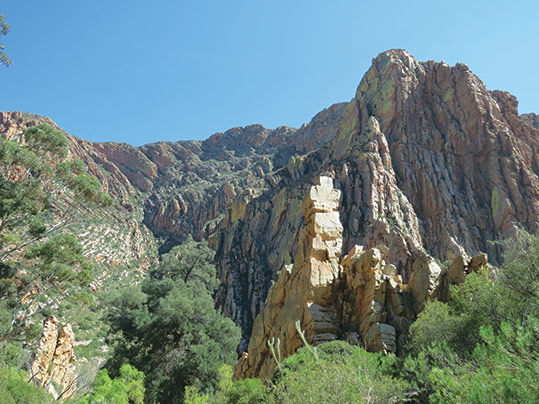
Vertically dipping quartzite strata of the folded Cape Supergroup at the northern end of the Swartberg Pass, near Prince Albert
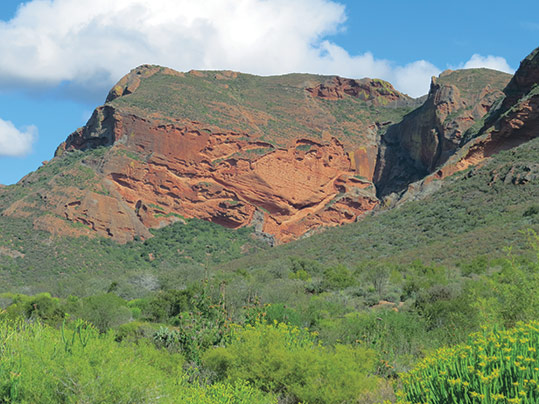
Red-bed conglomerates of the Uitenhage Group east of Oudtshoorn in the Klein Karoo, deposited in a continental semi-graben during the Cretaceous
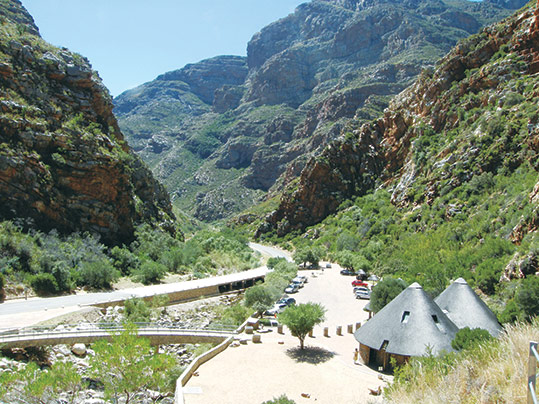
Spectacular folding and thrusting of the Cape Fold Belt are magnificently seen in Meiringspoort, a gorge through the Swartberg linking the Klein and Great Karoos
Tuesday 6th September (DAY 3): Road trip to Barkly West, Wildebeestkuil Rock Art Centre and Kimberley’s Big Hole; overnight from Kimberley to Krugersdorp
Geology and landscape: Kimberley lies on the interior plateau in the centre of South Africa. The day starts with a trip to Barkly West and the historic Vaal River diggings at Canteen Koppie, where in 1870 South Africa’s first big diamond rush took place. On the return we will detour to the Nooitgedacht glacial pavement on Archaean Ventersdorp lava and later see numerous San Bushman petroglyphs etched on outcrops at the Wildebeeskuil. The day’s highlight will be the famous Big Hole, the world’s deepest hand-dug hole, and the mined-out location of the original Kimberley Pipe, one of a cluster of large diamond-rich kimberlite pipes of Cretaceous age in the area. There is a historic mining village, world-class displays and a diamond exhibition. Later the train travels overnight to Krugersdorp west of Johannesburg.
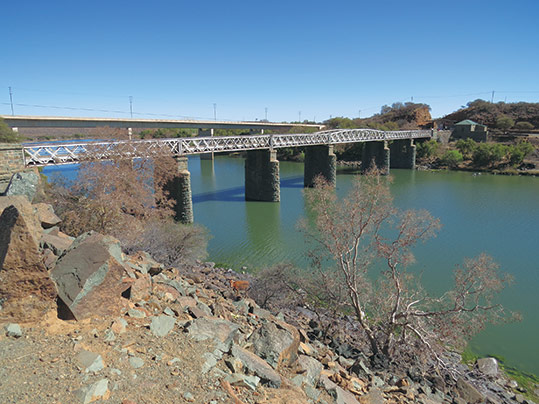
Vaal River and the old bridge (dated 1884) at Barkly West, site of South Africa’s first big diamond rush in 1870, near Canteen Koppie
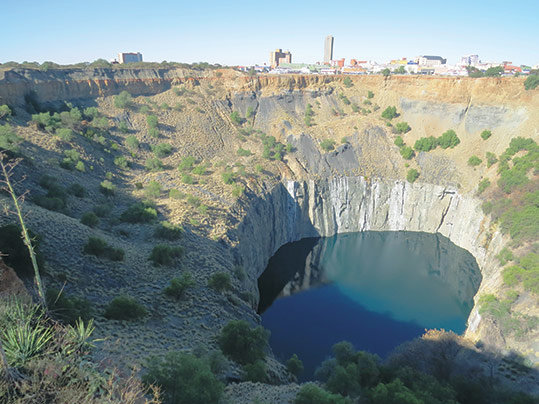
Kimberley’s Big Hole, the deepest hand-dug hole in the world and once the site of a famous, diamond-rich kimberlite pipe, one of a cluster in the area
Wednesday 7th September (Day 4): Optional tours to either Sterkfontein Caves and the Cradle of Humankind, or to see Witwatersrand geology and visit Gold Reef City; overnight from the Pretoria area to Musina
The group will disembark at Krugersdorp station for one of the optional tours, either a ‘Cradle of Humankind’ tour or a ‘Witwatersrand Geology’ tour. The tours will rejoin the train in the late afternoon outside Pretoria from where it will travel northwards to Musina.
‘Cradle of Humankind’ geology and landscape: This area is underlain by Late Archean stromatolite-bearing Malmani Dolomite, part of the Transvaal Supergroup that here forms a treasure house of caves, and is a renowned World Heritage Site. You will go into Sterkfontein Caves, the discovery site of many of the world’s Australopithecus (ape-man) fossils, dated from around 2.5 million years ago, including the famous ‘Mrs Ples’ skull (found in 1947) and ‘Little Foot’ (found in 1997). Nearby Wonder Cave is a vast chamber full of amazing cave formations while the Maropeng visitor centre provides an unrivalled look at the evolution of the Earth and the path to humankind.
‘Witwatersrand’ geology and landscape: The ridges of the Witwatersrand form an east-west trending regional watershed that is part of South Africa’s Highveld Plateau. During the course of the day you will see a cross-section of Archaean Witwatersrand Supergroup stratigraphy, upwards from granites and greenstones of the Johannesburg Dome, the overlying West Rand Group and Central Rand sediments, the latter hosting the world’s largest goldfield. This tour will see the Geological Rock Garden and Trail at the Walter Sisulu National Botanical Garden, the discovery site of the Main Reef in 1886, and go down a working mine shaft at Gold Reef City.
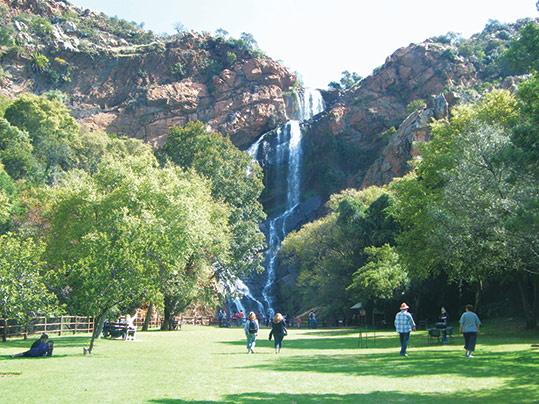
Witpoortjie Falls and south-dipping Orange Grove quartzite of the Witwatersrand Supergroup forms the backdrop, and start of the JCI Geological Trail at Walter Sisulu National Botanical Garden, near Krugersdorp
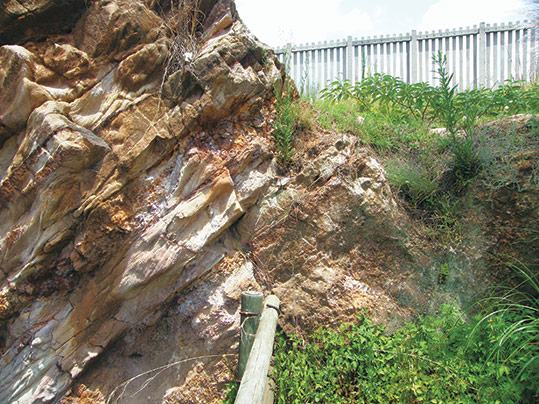
Exposed conglomerate and quartzite layers of the Main Reef and Main Reef Leader at their 1886 discovery site in George Harrison Park, west of central Johannesburg
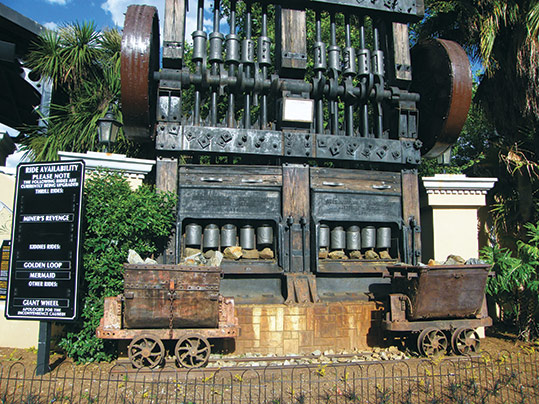
Historic 10-stamp rock crusher used on an early Witwatersrand gold mine, now standing at Gold Reef City on Crown Mines, Johannesburg
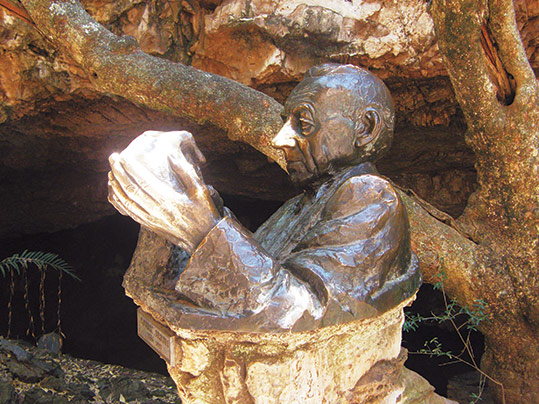
A commemorative bust of Dr Robert Broom holding the “Mrs Ples” skull, a hominin fossil that he found in 1947 at the Sterkfontein Caves, Cradle of Humankind near Krugersdorp
Thursday 8th September (Day 5): Optional tours to either Mapungubwe National Park or Sand River Gneiss and Soutpansberg; overnight from Musina – Rutenga (Zimbabwe)
After disembarking at Musina the group will have the option of either a tour to ‘Mapungubwe World National Park’ or to the famous ‘Sand River Gneisses & Soutpansberg’. Both tours will rejoin the train in the late afternoon before crossing into Zimbabwe.
Mapungubwe geology, landscape and archaeology: Located about 60 km west of Musina, at the confluence of the Limpopo and Shashe Rivers, and bordering Botswana and Zimbabwe. You will visit iconic Mapungubwe Hill that was once a rocky citadel of a southern African royal family, and the world-class interpretation centre where you will experience southern Africa’s 14th century cultural heritage. The area is underlain by upper Karoo sediments and remnants of basalt, and is a landscape formed by a dissected sandstone escarpment, mesas and buttes separated by wide sandy valleys. Notable are the unusual sandstone pillars that are interpreted to be fossilized termite nests of Early Jurassic age.
Sand River Gneiss & Soutpansberg geology and landscape: These formations lie south of Musina. You will first go to the to the famous tectonised gneiss and migmatite exposures in the usually dry Sand River valley which are part of the Archean Limpopo Metamorphic Complex that was formed during collision between the Kaapvaal and Zimbabwe Cratons. Later you will see the Mid-Proterozoic Soutpansberg massif in Wyllie’s Poort, in a sequence of strongly faulted, graben-related quartzites that represent one of Earth’s earliest ‘red-bed’ sequences.
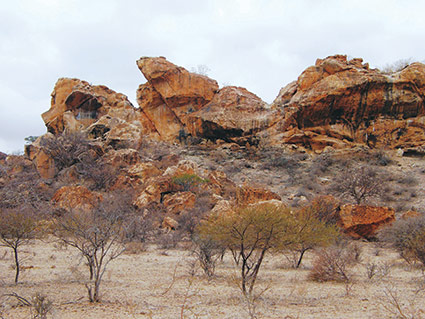
Collapsing escarpment of orange-weathering Clarens sandstone overlying greyish Elliot siltstone of upper Karoo-age, in Mapungubwe National Park, Limpopo
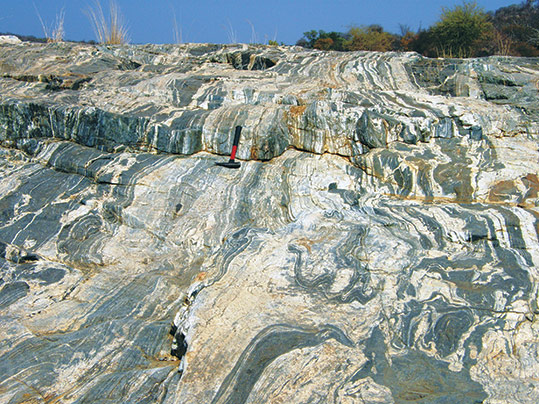
Incredible plastic deformation seen in high-grade gneisses and migmatites of the strongly metamorphosed Limpopo Complex, in the usually dry Sand River near Musina
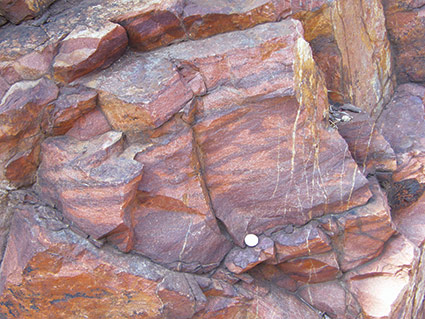
The hematite-rich, pink and maroon Soutpansberg Group quartzites seen in Wyllie’s Poort, Limpopo represents some of the Earth’s oldest red-beds, reflecting free oxygen becoming available in the atmosphere
Friday 9th September (Day 6): Great Zimbabwe National Monument; overnight to Bulawayo via Gweru
Geology, landscape and archaeology: You will disembark at Rutenga, Zimbabwe and drive bus (about 2 hours) to Great Zimbabwe, another World Heritage Site. This iconic monument is at the heart of Zimbabwe’s history and culture, and gives its name to the country. It is located in attractive hilly landscape underlain by eroded Archean granite, the same rock that was used for its impressive dry-stone construction. A powerful and thriving city-state existed at what is the largest stone construction south of the pyramids. People lived here for around 300 years until the late 15th century when it went into decline. There are several footpaths to be walked and a couple of hills to be climbed. In the afternoon the train departs for Bulawayo, Zimbabwe’s second largest city.
Saturday 10th September (Day 7): Rhodes Matopos National Park and Bulawayo; overnight to Victoria Falls
Geology, landscape and archaeology: An early rise is essential prior to departure on 4x4 vehicles for the Rhodes Matopos Hills National Park. Located south of Bulawayo this is another important World Heritage Site, characterized by spectacular scenery, interesting archaeology and a viewsite called “The View of the World”. The Matoba Hills provides a granite landscape showing typical whale-backs, balancing boulders, castle koppies and gorges. Granite intrusion took place in the Late Archean, and the area subsequently experienced a long and complex geological and erosional history. The hills were inhabited since the Early Stone Age and are richly endowed with countless rock paintings, some of which will be seen. Later if time permits we will visit the National Museum in Bulawayo. The train departs for its final overnight trip to Victoria Falls, arriving there around mid-morning.
Sunday 11th September (Day 8): View the Victoria Falls from both Zimbabwe and Zambia; the train stays at Victoria Falls station
Geology and landscape: Today could be the highlight of the geo-safari as we visit yet another World Heritage Site, one of the world’s great waterfalls. When the Zambezi River is in full flood the Victoria Falls forms the world’s longest continuous sheet of falling water. Notably the underlying basalt lavas are part of the Karoo magmatic event that took place in the Jurassic. This major knick-point on the Zambezi River separates the mature low gradient Upper Zambezi and the youthful, headward-eroding middle Zambezi. There is a fascinating geomorphological story to tell, the deep gorges below the falls representing a series major fracture zones and the sites of earlier waterfalls.
Monday 12th September (Day 9): Chobe National Park (Botswana) and river safari; the train stays at Victoria Falls station
A visit to Chobe National Park in Botswana, only 76 kms from Victoria Falls, is a MUST when visiting this area. One WILL see lots of game and a big variety as well. The geology that you see is part of the Cenozoic Kalahari Group. The cruise on the Chobe River will give wonderful opportunities for good pictures and this is a day NOT to be missed. Tonight we dine on the banks of the Zambesi River, a never-to-be forgotten experience. This is the last night on the train.
Tuesday 13th September (Day 10): End of a memorable geo-safari; passengers make their own arrangements
Breakfast will be served on board the train. If guests are transferring to a local hotel, this will be arranged for them in the morning. If guests are flying from Victoria Falls International Airport (18 km away) they will be transported to the airport. But we highly recommend that you stay another night or two before departing, as there is still so much to be seen and enjoyed.
 Field trips
Field trips  Sponsorship & expo
Sponsorship & expo  Registration
Registration Tours
Tours  Promotion
Promotion 

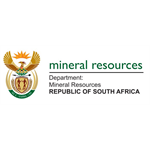












 Conference Programme
Conference Programme  Field trips
Field trips  Sponsorship & expo
Sponsorship & expo  Volunteer
Volunteer  GeoHost
GeoHost  Registration
Registration Tours
Tours  Promotion
Promotion  Publications
Publications


